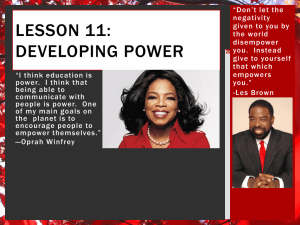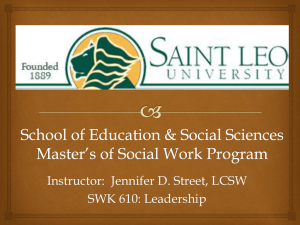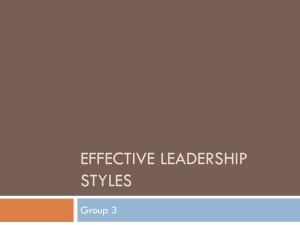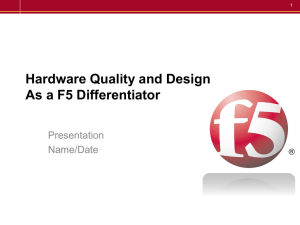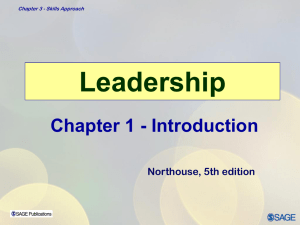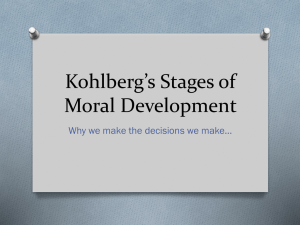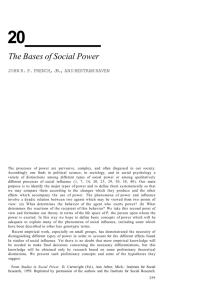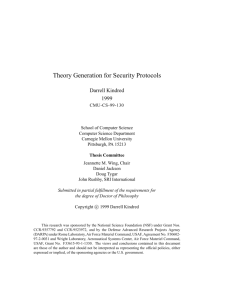ANSWERS - Novella
advertisement
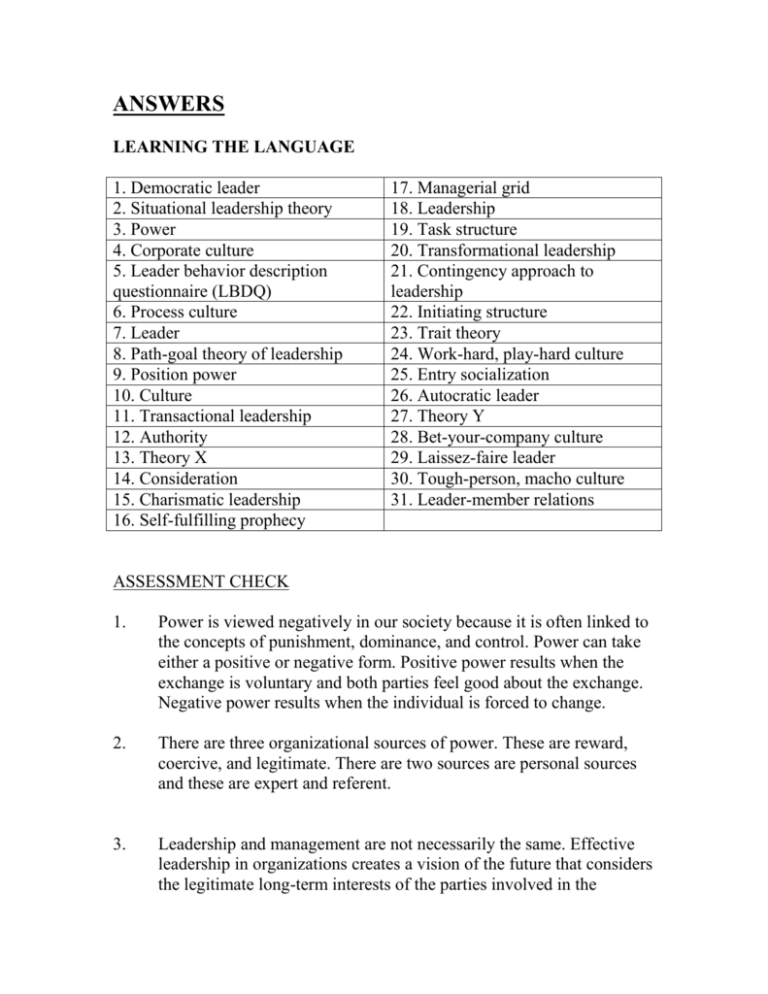
ANSWERS LEARNING THE LANGUAGE 1. Democratic leader 2. Situational leadership theory 3. Power 4. Corporate culture 5. Leader behavior description questionnaire (LBDQ) 6. Process culture 7. Leader 8. Path-goal theory of leadership 9. Position power 10. Culture 11. Transactional leadership 12. Authority 13. Theory X 14. Consideration 15. Charismatic leadership 16. Self-fulfilling prophecy 17. Managerial grid 18. Leadership 19. Task structure 20. Transformational leadership 21. Contingency approach to leadership 22. Initiating structure 23. Trait theory 24. Work-hard, play-hard culture 25. Entry socialization 26. Autocratic leader 27. Theory Y 28. Bet-your-company culture 29. Laissez-faire leader 30. Tough-person, macho culture 31. Leader-member relations ASSESSMENT CHECK 1. Power is viewed negatively in our society because it is often linked to the concepts of punishment, dominance, and control. Power can take either a positive or negative form. Positive power results when the exchange is voluntary and both parties feel good about the exchange. Negative power results when the individual is forced to change. 2. There are three organizational sources of power. These are reward, coercive, and legitimate. There are two sources are personal sources and these are expert and referent. 3. Leadership and management are not necessarily the same. Effective leadership in organizations creates a vision of the future that considers the legitimate long-term interests of the parties involved in the organization, develops a strategy for moving toward that vision, enlists the support of employees to produce the movement, and motivates employees to implement the strategy. Management is a process of planning, organizing, staffing, motivating, and controlling through the use of formal authority. 4. A person with a Theory X attitude believes the average human being has an inherent dislike of work and will avoid it if possible. Because of their dislike of work, most people must be coerced, controlled, directed, or threatened with punishment to get them to put forth adequate effort toward the achievement of organizational objectives. A Theory X person also believes the average human being prefers to be directed, wishes to avoid responsibility, has relatively little ambition, and wants security above all. 5. A person with a Theory Y attitude believes that the expenditure of physical and mental effort in work is as natural as play or rest. They believe that external control and the threat of punishment are not the only means for bringing about effort toward organizational objectives. Also, commitment to objectives is a function of the rewards associated with their achievement. Theory Y people believe that the average human being learns, under proper conditions, not only to accept but to seek responsibility. 6. A Theory X leader would likely use a much more authoritarian style of leadership than a leader who believes in Theory Y assumptions. A Theory X leader believes that the average human being has an inherent dislike of work and will avoid it if possible. They feel because of their dislike for work, most people must be coerced, controlled, directed, or threatened with punishment to get them to put forth adequate effort toward the achievement of organizational objectives. Theory Y leader believes the expenditures of physical and mental effort in work is as natural as play or rest. This type of leader believes the average human being learns, under proper conditions, not only to accept but to seek responsibility. 7. The leader (manager) would tell the employees what they need to do to obtain the rewards. The leader would also take corrective action only when employees fail to meet performance objectives. 8. The manager-employee relationship is one of mutual encouragement and is characterized by personality on the part of the leader, inspiration by the leader, consideration by the leader of individual needs, and intellectual motivation between the leader and followers. 9. Charismatic leaders powerfully communicate a compelling vision of the future. These leaders are passionate about their vision and believe in it. They relentlessly promote their beliefs with boundless energy and put forward creative “outside the box” ideas. They also inspire extraordinary performances in followers by expressing confidence in followers’ abilities to achieve high standards and by building followers’ trust, faith, and belief in the leader. 10. The first is substance, the meanings contained in its values, norms, and beliefs. The second is forms, the practices whereby these meanings are expressed, affirmed, and communicated to members. 11. A strong corporate culture is clearly defined, reinforces a common understanding about what is important, and has the support of management and employees. In a weak corporate culture, individuals often act in ways that are inconsistent with the company’s way of doing things. 12. The first is the organization has strong values that do not fit into a changing environment. The industry is very competitive and moves with lightning speed. The third reason is that the organization is mediocre or worse. The organizations is about to join the ranks of the very large companies. Lastly, the organization is small but growing rapidly. CRITICAL THINKING EXERCISES 1. Students answers will vary. The five powers consist of reward, coercive, legitimate, expert, and referent. In a retail setting, referent and reward would best motivate and lead your employees. Referent power is a sign of respect and makes other people want to associate with you. Reward would be useful in a retail setting because most positions would be in sales. Legitimate would obviously be used because of the management title held; however, this doesn’t always gain the respect from employees. 2. Your answer will of course be determined by your own experience. The key is to look at how your manager fits into the new style of management, or if he or she is more traditional. If you work for a small firm, it may be that your manager acts in a more traditional manner, for example. But, if the company you work for is a larger organization, management styles may be different. 3. A. B. C. D. E. F. 4. As a manager of educated and skilled workers you are less likely to be giving specific instructions to your employees. Instead, you may give them the authority to make decisions, which will allow them to respond quickly to any customer requests. In all likelihood, you will set up a team approach for the plant, using self-managed work teams if possible. Your job will be more that of a coach and team member, allowing for more participation in decision-making and more flexibility for the workers. Theory Y Theory Y Theory X Theory Y Theory Y Theory X The top manager will be concerned with a broader view of where he wants the company to go. As a first line manager, your job will be more specific, and your goals and objectives more specific than those the top manager has outlined for the entire company. So your directions to subordinates, to the extent you will give them direction, will be more specific. 5. A. B. C. 6. a. b. a. b. a. b. Autocratic Democratic Democratic Laissez-Faire Democratic Autocratic Your boss appears to see the importance of customer service and high quality products in today’s competitive marketplace. She has a vision of how she wants the division to operate, which is a characteristic of a good leader. She trusts employees to make their own decisions, thus empowering them with control over their jobs. This helps to create a sense of loyalty and job satisfaction amongst workers. She believes in a democratic leadership approach which is important for effectively managing today’s new style of worker. Her leadership style promotes participation throughout the organization. The norms and morals that she has set in place (trust, quality, and customer service) is wellknown and expected company-wide. PRACTICE TEST MULTIPLE CHOICE TRUE FALSE 1. B 2. D 3. C 4. A 5. C 6. B 7. B 1. True 2. True 3. False 4. True 5. False 6. True 7. False 8. True 9. False 8. D 9. A 10. C 11. C 12. D 13. A 14. B 10. True 11. False 12. False 13. True 14. True 15. False 16. True 17. True 18. False
